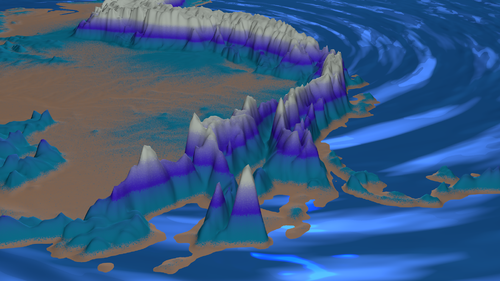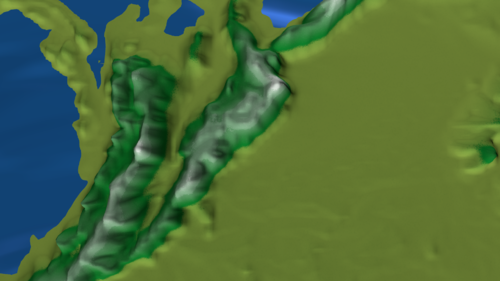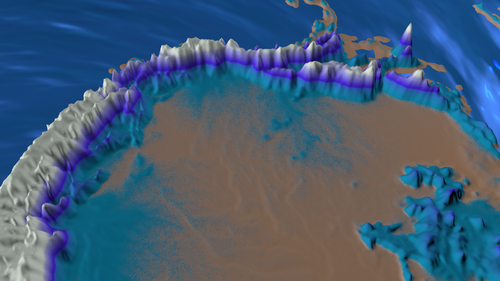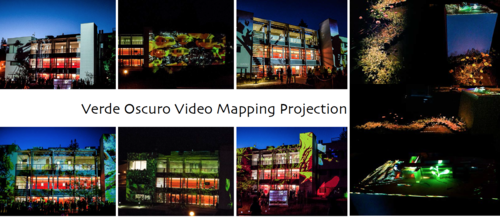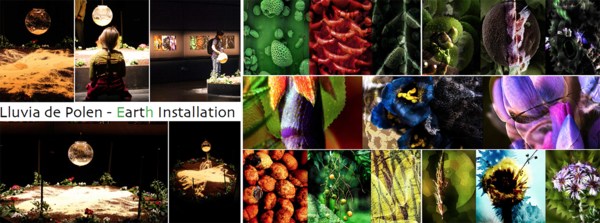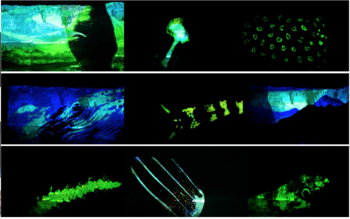User:Catalina/Proposal: Difference between revisions
(Created page with "Draft Proposal Time machine: ice ages in the Andes or Sky Islands in the Andes Mountains September 20th 2017 What do you want to make? I want to explore 3D animation and d...") |
No edit summary |
||
| (25 intermediate revisions by 3 users not shown) | |||
| Line 1: | Line 1: | ||
== Title == | |||
<big>'''Sky Islands of the Andes Mountains or Time machine: ice ages in the Andes'''</big> | |||
[[File:Andes Flickering FCS0303.png|500px]] | |||
[[File:Andes 4 0605.png|500px]] | |||
[[File:Andes Flickering FCS0322.png|500px]] | |||
== Introduction == | |||
Sky Islands of the Andes Mountains is an exploration of how to display scientific information using digital art, 3D animation, and data visualization as the contemporary tools to imagine ecosystems in the past times. Francoeur mentioned in 1997 that sciences and arts overlap each other by giving shape to a new creation that enlightens insights, triggers our imagination and help to put ideas into a new perspective. Thus, subjects that are complex in multiple dimensions can highly benefit from the integration between theoretical knowledge and modeling with simulations and scientific visualization, shaping our sensory experience on something that by definition can neither be touched nor seen. Likewise, the current convergence between science, art, and technology is a path to create education models for the 21st century that trigger envisions to understand hypotheses and theories from different science fields. This art-science-tech collaboration will be also a powerful instrument to create awareness about the importance of evolution in the South American Andes ecosystems and its biodiversity. | |||
Sky Islands of the Andes Mountains is like a time machine to visualize the effect of the ice ages in the Northern Andes during the last million years. This project is a collaboration with the group of Palaeoecology and Landscape Ecology (P&L) at the University of Amsterdam. This group has been studying the Páramos and Andean ecosystems for over 50 years, focusing both on its relevance in present and past times (see studies from A. Cleef and T. van der Hammen and H. Hooghiemstra, among others). Their studies have shown the Páramos are highly diverse ecosystems currently restricted to mountain tops (resembling an archipelago of islands) but in the past dominated large surface areas throughout the Northern. Driven by large scale cycles of climate change, the páramo ‘islands’ shifted altitudinally along the mountain slopes, heavily influenced by the topography that determined the degree of Páramo fragmentation and connectivity in the past. During cold conditions, the low elevational position of the Páramos cause the many isolated Páramo islands to fuse, while during warmer conditions the Páramos form isolated archipelagos. The biogeographic history of the Páramos has been reconstructed for the last million years and exposes the driver of the evolutionary powerhouse, a mechanism described as the ‘flickering connectivity system’ (Flantua 2017). This project will envision how the shifting elevational distributions of the Andean ecosystems (páramos, Andean forests, and lowlands forests) was caused by cold and warm conditions driven by cycles in a macro scale of time and space, called the Milankovitch cycles (Muller et.al 1997) | |||
== Methodology. How do you plan to make it? == | |||
I want to create a time machine to travel in the past times of Andes mountains to understand how the ecosystems and plants evolved in time. For this, I am using 3D animation programs as Cinema 4D, VUE, After Effects and Adobe Premier. To generate the landscapes of Andes mountains I am using digital terrain models from satellite images. | |||
The storytelling of this project is based on pollen fossil, carbon 14 dating and sediments records that have been tools to approach the ecosystems and climate in the past. Materials that have been preserved thousands of years in the mountain lakes are witnesses able to tell us the history of how the Paramos changed on a large scale of time and space. Many of the papers I am using have been published from The Research group of Palaeoecology and Landscape Ecology (P&L) of University of Amsterdam. | |||
The story timeline will take place in a period of one millions of years to the present times. The 3D animation will have two points of view which acts as a mirror. In one side, the Earth and Sun's cycles from outside of the planet, and the other side the Earth in the Andes mountains. The screen can be divided in two, the first half screen will show the process led by the movements outside of the Earth around the sun and herself, cycles that have an effect on the Earth's climate on a scale of thousands of years (100.000, 40.000 and 26.000). The other half will be displayed with the same cycles but as a closer in the mountains. The idea is to show 12 scenarios that were found as the most relevant moments or snapshots to explain the process of evolution and climate change effect on plants and its diversification. | |||
One of the possible outcomes will be an immersive 360 degrees video installation, the half screen will display the cycles outside of the Earth and the second half, the process happening in the mountains as a reflection of the Sun-Earth cycles. | |||
The second possible outcome is a video installation using two confronted screens, but in this case, one screen will display the cycles outside of the Earth and the second screen the process happening in the mountains as a reflection of the Sun-Earth cycles. | |||
== What is your timetable? == | |||
{| class="wikitable" | |||
|- | |||
! Steps Process !! 4 Trimester !! 5 Trimester !! 6 Trimester | |||
|- | |||
| Storyboard ||x || || | |||
|- | |||
| 3D Animation || x || x || x | |||
|- | |||
| Final editing +Revisions || || || x | |||
|- | |||
| Video Installation || || || x | |||
|- | |||
|} | |||
== Why do you want to make it? == | |||
My interest is to explore how to communicate visually the results published in a scientific way. I want to transform the information published for studies made in the Andes for over the last 50 years. Studies focused both on its relevance in present and past times of páramos and Andean ecosystems. The ‘páramos’ of the Northern Andes is an interesting case study area because they are supported by unique long fossil pollen records and developed conceptual frameworks (Flantua et al., 2014, Flantua & Hooghiemstra, 2017; Groot, 2012; Torres et al., 2005, 2013; Van der Hammen 1974). | |||
In the same way, I believe this project will have a significant impact in various fields. First of all, decades of knowledge on the evolution in Andean ecosystems will be integrated, providing a much needed interface for multi-disciplinary research between paleoecology, phylogeography, macroecology and paleoclimate. Secondly, strong information graphics will trigger new initiatives in mountain research globally, elucidating the origin of biodiversity in an unprecedented manner. Additionally, it will help students to better understand the dynamic history of the páramo ecosystem and high mountain ecosystems in general. Finally, the visualization will be relevant for a very large public including scientists and universities, new media artists, schools, policy makers and governments. | |||
== Who can help you or how? == | |||
This is collaboration project with the research team of Palaeoecology at the Institute of Biodiversity and Ecosystem Dynamics, University of Amsterdam, which will be supported in Science by PhD. Suzette Flantua and Professor Henry Hooghiemstra. They will provide advice in science research, data and publications that will be the core of the visualization script and story. As well I will have the support of Arts advisors at Piet Zwart Institute as Simon Pummell, Barend Onneweer, David Haines, Ine Lamers, Javier Lloret, Marloes de Valk and some professors at Willem de Kooning Academy for data visualization work. | |||
Relation to | == Relation to previous practice? == | ||
As a biologist I have been working in different research teams that investigate the past, present, and future ecosystems in Colombia. My interests as a researcher have been to understand how the changes in climate have been modifying plants and vegetation through different periods of time and space but also how to communicate that in a visual form. Today, my interest as visual artist is to explore how to transform the knowledge created through the lens of science in a visual art piece using 3D animation. For the reasons above I have been exploring life plant installations, video mapping projection and photography of nature. Some of the projects I have done before took shape between 2011 and 2017 and were supported by many artists and technicians at the University of California- Santa Cruz, Piet Zwart Institute, Science Park (UvA) and the Eye Filmmuseum. (More info here http://www.catalhinagiraldo.com/art-installations) | |||
[[File:Verde Oscuro.png|500px]] | |||
[[File:Screen Shot 2017-04-18 at 21.14.08.png|600px]] | |||
[[File:Fluctuations.png|350px]] | |||
== Relation to a larger context? == | |||
In a larger context sense, the piece would be outlined inside the conceptual movement of artists exploring the metaphorical language of Planet Earth which started in the 70's, like “Planet Earth in Contemporary Electronic Artworks” and “Environmental Art”, which expression coined as an umbrella term to encompass Eco-Art/Ecological Art, Ecoventions, Land Art, Earth Art, Earthworks, and Art in Nature (Knebusch, 2004; Bower, 2010). To bring some examples for Environmental Art, there are over 150 artists, and close to 22 scientists and Science & Arts collaborative projects, organizations, programs, and residencies focused on this Eco-Art movement around the world (The Greenmuseum, 2010). A number that have been increasing with the current ‘Art in the Anthropocene”, a massive trans-disciplinary movement of artists, designers and scholars exploring the symbolic language of the Anthropocene (Anthropocene Agents, 2017; Dickinson, 2015; Alonso, 2015; Bourriaud, 2014). Artists since the 70’s that have been engaging audiences for climate change, restoration of ecosystems and protection of watersheds using models for sustainable restoration are Newton & Helen Mayer Harrison, AMD&ART/ T., Allan Comp, Jean Paul Ganem, Tim Collins & Reiko Goto, Yolanda Gutiérrez, Patricia Johanson, Lynne Hull, Ichi Ikeda and Aviva Rahmani. | |||
== References == | |||
Alonso C. (2015). Artistic practices, discursive contexts and environmental humanities in the Age of the Anthropocene. Artnodes 15, I ISSN 1695-5951. | Alonso C. (2015). Artistic practices, discursive contexts and environmental humanities in the Age of the Anthropocene. Artnodes 15, I ISSN 1695-5951. | ||
| Line 55: | Line 65: | ||
Dickinson, B. (2015). Pleistocene, Holocene, Anthropocene. Features 02, ART MONTHLY, Sep 15, 389 pg. | Dickinson, B. (2015). Pleistocene, Holocene, Anthropocene. Features 02, ART MONTHLY, Sep 15, 389 pg. | ||
Flantua, S.G.A., Hooghiemstra, H., Van Boxel, J.H., Cabrera, M., González-Carranza, Z., González-Arango, C. | Flantua, S.G.A., Hooghiemstra, H., Van Boxel, J.H., Cabrera, M., González-Carranza, Z., González-Arango, C., 2014. Connectivity dynamics since the Last Glacial Maximum in the northern Andes; a pollen-driven framework to assess potential migration, in: Stevens, W.D., Montiel, O.M., Raven, P.H. (Eds.), Paleobotany and Biogeography: A Festschrift for Alan Graham in His 80th Year. Missouri Botanical Garden, St. Louis, pp. 98–123. | ||
Flantua, S.G.A. & Hooghiemstra, H. (2017) Historical connectivity and mountain biodiversity. In: Hoorn, C., Perrigo, A., Antonelli, A. (eds). Mountains, Climate and Biodiversity. Wiley, Oxford, UK. | Flantua, S.G.A. & Hooghiemstra, H. (2017) Historical connectivity and mountain biodiversity. In: Hoorn, C., Perrigo, A., Antonelli, A. (eds). Mountains, Climate and Biodiversity. Wiley, Oxford, UK. | ||
| Line 61: | Line 71: | ||
Francoeur, E. (1997). The Forgotten Tool: The Design and Use of Molecular Models. Social Studies of Science. 27(1), 7-40. | Francoeur, E. (1997). The Forgotten Tool: The Design and Use of Molecular Models. Social Studies of Science. 27(1), 7-40. | ||
Groot | Groot M.H.M. (2012). ‘’Solving a Piece of the puzzle’’. Reconstruction of millennial-scale environmental and climatic change in the northern Andes during the last glacial cycle: An integration of biotic and abiotic proxy-information. PhD Thesis. University of Amsterdam. | ||
Knebusch, J. (2004). Planet Earth in Contemporary Electronic Artworks. Leonardo 37 (1), 18-24. URL: http://muse.jhu.edu/journals/len/summary/v037/37.1knebusch.html (accessed 06-04-2017). | Knebusch, J. (2004). Planet Earth in Contemporary Electronic Artworks. Leonardo 37 (1), 18-24. URL: http://muse.jhu.edu/journals/len/summary/v037/37.1knebusch.html (accessed 06-04-2017). | ||
Muller R. A. & MacDonald G. (1997). Glacial Cycles and Astronomical Forcing. Science 277 (5323): 215–8. | |||
Symposium Agents in the Anthropocene: Trans/disciplinary practices in art and design education today. (2017).Piet Zwart Institute / Willem de Kooning Academy, Rotterdam. January 27-28, 2017. https://www.anthropoceneagents.nl (accessed 04-18-2017). | Symposium Agents in the Anthropocene: Trans/disciplinary practices in art and design education today. (2017).Piet Zwart Institute / Willem de Kooning Academy, Rotterdam. January 27-28, 2017. https://www.anthropoceneagents.nl (accessed 04-18-2017). | ||
The Greenmuseum | The Greenmuseum (2010). URL: http://www.greenmuseum.org/. (accessed 06-04-2017). | ||
Torres, V., Vandenberghe, J., Hooghiemstra, H. (2005). An environmental reconstruction of the sediment infill of the Bogotá basin (Colombia) during the last 3 million years from abiotic and biotic proxies. Palaeogeography, Palaeoclimatology, Palaeoecology 226, 127–148. doi:10.1016/j.palaeo.2005.05.005 | Torres, V., Vandenberghe, J., Hooghiemstra, H. (2005). An environmental reconstruction of the sediment infill of the Bogotá basin (Colombia) during the last 3 million years from abiotic and biotic proxies. Palaeogeography, Palaeoclimatology, Palaeoecology 226, 127–148. doi:10.1016/j.palaeo.2005.05.005 | ||
Torres, V., Hooghiemstra, H., Lourens, L., Tzedakis, P.C. (2013). Astronomical tuning of long pollen records reveals the dynamic history of montane biomes and lake levels in the tropical high Andes during the Quaternary. Quaternary Science Reviews 63, 59–72. doi:10.1016/j.quascirev.2012.11.004 | Torres, V., Hooghiemstra, H., Lourens, L., Tzedakis, P.C. (2013). Astronomical tuning of long pollen records reveals the dynamic history of montane biomes and lake levels in the tropical high Andes during the Quaternary. Quaternary Science Reviews 63, 59–72. doi:10.1016/j.quascirev.2012.11.004 | ||
Van der Hammen, T. (1974) The Pleistocene changes of vegetation and climate in tropical South America. Journal of Biogeography 1, 3-26. | Van der Hammen, T. (1974) The Pleistocene changes of vegetation and climate in tropical South America. Journal of Biogeography 1, 3-26. | ||
Latest revision as of 15:09, 26 October 2017
Title
Sky Islands of the Andes Mountains or Time machine: ice ages in the Andes
Introduction
Sky Islands of the Andes Mountains is an exploration of how to display scientific information using digital art, 3D animation, and data visualization as the contemporary tools to imagine ecosystems in the past times. Francoeur mentioned in 1997 that sciences and arts overlap each other by giving shape to a new creation that enlightens insights, triggers our imagination and help to put ideas into a new perspective. Thus, subjects that are complex in multiple dimensions can highly benefit from the integration between theoretical knowledge and modeling with simulations and scientific visualization, shaping our sensory experience on something that by definition can neither be touched nor seen. Likewise, the current convergence between science, art, and technology is a path to create education models for the 21st century that trigger envisions to understand hypotheses and theories from different science fields. This art-science-tech collaboration will be also a powerful instrument to create awareness about the importance of evolution in the South American Andes ecosystems and its biodiversity. Sky Islands of the Andes Mountains is like a time machine to visualize the effect of the ice ages in the Northern Andes during the last million years. This project is a collaboration with the group of Palaeoecology and Landscape Ecology (P&L) at the University of Amsterdam. This group has been studying the Páramos and Andean ecosystems for over 50 years, focusing both on its relevance in present and past times (see studies from A. Cleef and T. van der Hammen and H. Hooghiemstra, among others). Their studies have shown the Páramos are highly diverse ecosystems currently restricted to mountain tops (resembling an archipelago of islands) but in the past dominated large surface areas throughout the Northern. Driven by large scale cycles of climate change, the páramo ‘islands’ shifted altitudinally along the mountain slopes, heavily influenced by the topography that determined the degree of Páramo fragmentation and connectivity in the past. During cold conditions, the low elevational position of the Páramos cause the many isolated Páramo islands to fuse, while during warmer conditions the Páramos form isolated archipelagos. The biogeographic history of the Páramos has been reconstructed for the last million years and exposes the driver of the evolutionary powerhouse, a mechanism described as the ‘flickering connectivity system’ (Flantua 2017). This project will envision how the shifting elevational distributions of the Andean ecosystems (páramos, Andean forests, and lowlands forests) was caused by cold and warm conditions driven by cycles in a macro scale of time and space, called the Milankovitch cycles (Muller et.al 1997)
Methodology. How do you plan to make it?
I want to create a time machine to travel in the past times of Andes mountains to understand how the ecosystems and plants evolved in time. For this, I am using 3D animation programs as Cinema 4D, VUE, After Effects and Adobe Premier. To generate the landscapes of Andes mountains I am using digital terrain models from satellite images. The storytelling of this project is based on pollen fossil, carbon 14 dating and sediments records that have been tools to approach the ecosystems and climate in the past. Materials that have been preserved thousands of years in the mountain lakes are witnesses able to tell us the history of how the Paramos changed on a large scale of time and space. Many of the papers I am using have been published from The Research group of Palaeoecology and Landscape Ecology (P&L) of University of Amsterdam. The story timeline will take place in a period of one millions of years to the present times. The 3D animation will have two points of view which acts as a mirror. In one side, the Earth and Sun's cycles from outside of the planet, and the other side the Earth in the Andes mountains. The screen can be divided in two, the first half screen will show the process led by the movements outside of the Earth around the sun and herself, cycles that have an effect on the Earth's climate on a scale of thousands of years (100.000, 40.000 and 26.000). The other half will be displayed with the same cycles but as a closer in the mountains. The idea is to show 12 scenarios that were found as the most relevant moments or snapshots to explain the process of evolution and climate change effect on plants and its diversification. One of the possible outcomes will be an immersive 360 degrees video installation, the half screen will display the cycles outside of the Earth and the second half, the process happening in the mountains as a reflection of the Sun-Earth cycles. The second possible outcome is a video installation using two confronted screens, but in this case, one screen will display the cycles outside of the Earth and the second screen the process happening in the mountains as a reflection of the Sun-Earth cycles.
What is your timetable?
| Steps Process | 4 Trimester | 5 Trimester | 6 Trimester |
|---|---|---|---|
| Storyboard | x | ||
| 3D Animation | x | x | x |
| Final editing +Revisions | x | ||
| Video Installation | x |
Why do you want to make it?
My interest is to explore how to communicate visually the results published in a scientific way. I want to transform the information published for studies made in the Andes for over the last 50 years. Studies focused both on its relevance in present and past times of páramos and Andean ecosystems. The ‘páramos’ of the Northern Andes is an interesting case study area because they are supported by unique long fossil pollen records and developed conceptual frameworks (Flantua et al., 2014, Flantua & Hooghiemstra, 2017; Groot, 2012; Torres et al., 2005, 2013; Van der Hammen 1974).
In the same way, I believe this project will have a significant impact in various fields. First of all, decades of knowledge on the evolution in Andean ecosystems will be integrated, providing a much needed interface for multi-disciplinary research between paleoecology, phylogeography, macroecology and paleoclimate. Secondly, strong information graphics will trigger new initiatives in mountain research globally, elucidating the origin of biodiversity in an unprecedented manner. Additionally, it will help students to better understand the dynamic history of the páramo ecosystem and high mountain ecosystems in general. Finally, the visualization will be relevant for a very large public including scientists and universities, new media artists, schools, policy makers and governments.
Who can help you or how?
This is collaboration project with the research team of Palaeoecology at the Institute of Biodiversity and Ecosystem Dynamics, University of Amsterdam, which will be supported in Science by PhD. Suzette Flantua and Professor Henry Hooghiemstra. They will provide advice in science research, data and publications that will be the core of the visualization script and story. As well I will have the support of Arts advisors at Piet Zwart Institute as Simon Pummell, Barend Onneweer, David Haines, Ine Lamers, Javier Lloret, Marloes de Valk and some professors at Willem de Kooning Academy for data visualization work.
Relation to previous practice?
As a biologist I have been working in different research teams that investigate the past, present, and future ecosystems in Colombia. My interests as a researcher have been to understand how the changes in climate have been modifying plants and vegetation through different periods of time and space but also how to communicate that in a visual form. Today, my interest as visual artist is to explore how to transform the knowledge created through the lens of science in a visual art piece using 3D animation. For the reasons above I have been exploring life plant installations, video mapping projection and photography of nature. Some of the projects I have done before took shape between 2011 and 2017 and were supported by many artists and technicians at the University of California- Santa Cruz, Piet Zwart Institute, Science Park (UvA) and the Eye Filmmuseum. (More info here http://www.catalhinagiraldo.com/art-installations)
Relation to a larger context?
In a larger context sense, the piece would be outlined inside the conceptual movement of artists exploring the metaphorical language of Planet Earth which started in the 70's, like “Planet Earth in Contemporary Electronic Artworks” and “Environmental Art”, which expression coined as an umbrella term to encompass Eco-Art/Ecological Art, Ecoventions, Land Art, Earth Art, Earthworks, and Art in Nature (Knebusch, 2004; Bower, 2010). To bring some examples for Environmental Art, there are over 150 artists, and close to 22 scientists and Science & Arts collaborative projects, organizations, programs, and residencies focused on this Eco-Art movement around the world (The Greenmuseum, 2010). A number that have been increasing with the current ‘Art in the Anthropocene”, a massive trans-disciplinary movement of artists, designers and scholars exploring the symbolic language of the Anthropocene (Anthropocene Agents, 2017; Dickinson, 2015; Alonso, 2015; Bourriaud, 2014). Artists since the 70’s that have been engaging audiences for climate change, restoration of ecosystems and protection of watersheds using models for sustainable restoration are Newton & Helen Mayer Harrison, AMD&ART/ T., Allan Comp, Jean Paul Ganem, Tim Collins & Reiko Goto, Yolanda Gutiérrez, Patricia Johanson, Lynne Hull, Ichi Ikeda and Aviva Rahmani.
References
Alonso C. (2015). Artistic practices, discursive contexts and environmental humanities in the Age of the Anthropocene. Artnodes 15, I ISSN 1695-5951.
Bourriaud, N. (2014). The great acceleration. Art in the Anthropocene. http://www.taipeibiennial.org:8080/index.php/en/tb2014?phpMyAdmin=ef6946252cea3105a72033fb2f279321. (accessed 18-04-2017).
Bower, S. (2010). A Profusion of Terms. Greenmuseum.org. URL: http://greenmuseum.org/generic_content.php?ct_id=306. (accessed 06-04-2017).
Dickinson, B. (2015). Pleistocene, Holocene, Anthropocene. Features 02, ART MONTHLY, Sep 15, 389 pg.
Flantua, S.G.A., Hooghiemstra, H., Van Boxel, J.H., Cabrera, M., González-Carranza, Z., González-Arango, C., 2014. Connectivity dynamics since the Last Glacial Maximum in the northern Andes; a pollen-driven framework to assess potential migration, in: Stevens, W.D., Montiel, O.M., Raven, P.H. (Eds.), Paleobotany and Biogeography: A Festschrift for Alan Graham in His 80th Year. Missouri Botanical Garden, St. Louis, pp. 98–123.
Flantua, S.G.A. & Hooghiemstra, H. (2017) Historical connectivity and mountain biodiversity. In: Hoorn, C., Perrigo, A., Antonelli, A. (eds). Mountains, Climate and Biodiversity. Wiley, Oxford, UK.
Francoeur, E. (1997). The Forgotten Tool: The Design and Use of Molecular Models. Social Studies of Science. 27(1), 7-40.
Groot M.H.M. (2012). ‘’Solving a Piece of the puzzle’’. Reconstruction of millennial-scale environmental and climatic change in the northern Andes during the last glacial cycle: An integration of biotic and abiotic proxy-information. PhD Thesis. University of Amsterdam.
Knebusch, J. (2004). Planet Earth in Contemporary Electronic Artworks. Leonardo 37 (1), 18-24. URL: http://muse.jhu.edu/journals/len/summary/v037/37.1knebusch.html (accessed 06-04-2017).
Muller R. A. & MacDonald G. (1997). Glacial Cycles and Astronomical Forcing. Science 277 (5323): 215–8.
Symposium Agents in the Anthropocene: Trans/disciplinary practices in art and design education today. (2017).Piet Zwart Institute / Willem de Kooning Academy, Rotterdam. January 27-28, 2017. https://www.anthropoceneagents.nl (accessed 04-18-2017).
The Greenmuseum (2010). URL: http://www.greenmuseum.org/. (accessed 06-04-2017).
Torres, V., Vandenberghe, J., Hooghiemstra, H. (2005). An environmental reconstruction of the sediment infill of the Bogotá basin (Colombia) during the last 3 million years from abiotic and biotic proxies. Palaeogeography, Palaeoclimatology, Palaeoecology 226, 127–148. doi:10.1016/j.palaeo.2005.05.005
Torres, V., Hooghiemstra, H., Lourens, L., Tzedakis, P.C. (2013). Astronomical tuning of long pollen records reveals the dynamic history of montane biomes and lake levels in the tropical high Andes during the Quaternary. Quaternary Science Reviews 63, 59–72. doi:10.1016/j.quascirev.2012.11.004 Van der Hammen, T. (1974) The Pleistocene changes of vegetation and climate in tropical South America. Journal of Biogeography 1, 3-26.

